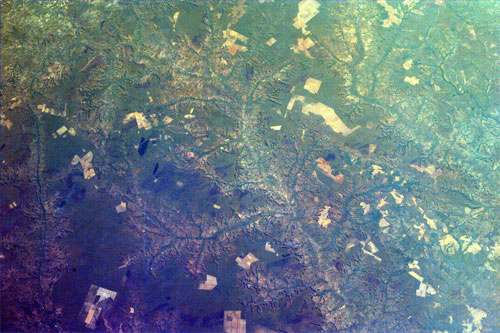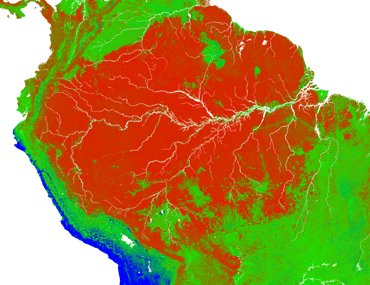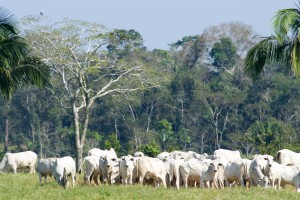The day the group of journalists I was visiting Brazil with by an invitation of Apex, a trade and investment agency, arrived in Brasilia for a series of meetings with government officials, the news was good. The country had managed to reduce deforestation in the Amazon region by 47% between August 2009 and May 2010, compared with the previous year. It went down from 1,142 square miles during the 2008/2009 period to 604.3 square miles over the last year. It still sounds like a lot, but when you consider that in 2004, a peak deforestation year, 10,588 square miles of Amazonian forest was destroyed, the number represents a drastic reduction. But the ravaging goes on. In June, another 66.4 square miles of forest were destroyed.
Our first stop was lunch with Ibama’s board. Ibama (Brazilian Institute of Environment and Natural Resources) is a jack of all trades in Brazil. It carries out surveillance, monitoring, prevents and fights forest fires, protects biodiversity and natural resources, provides environmental information, issues permits and licenses, etc. It’s a household name in Brazil with local chapters all over the country. It’s always in the news due to the terrifying number of stories related to wildlife trafficking, a billion-dollar industry that threatens biodiversity all over the world.
But during our lunch meeting, Ibama was in celebratory mood and the topic was the fight against deforestation, Brazil’s chief concern in terms of preservation, since it accounts for 75% of its carbon emissions. Therefore, curbing deforestation is key to meeting emissions reduction targets (around 37% by 2020) agreed up at the COP15 in Copenhagen last October.
We are given a presentation by George Porto Ferreira, the coordinator of Ibama’s environmental zoning and monitoring, who tells us about the organization’s Remote Sensing and Geographic Information systems. That’s how Ibama surveys the vast Amazon region, thanks to technology developed by Brazil’s space agency INPE and Japan’s Advanced Land Observing Satellite. There are two main methodologies: Prodes and Deter, which is fortnightly in terms of delivery. It has become more efficient, but it’s less so on cloudy days. Information received from INPE is sent to ground staff on the same day. These use a cross-reference system to set the priorities, according to location and scale of deforestation.

Some would argue that deforestation has gone down due to economic reasons. With a stronger currency and the global credit crunch, Brazilian commodities have gone up in price, and demand has decreased accordingly. But Ibama likes to think it is winning the war.
“Deforestation has decreased in pace with economic growth, which is a reason to celebrateâ€, says Director of Environmental Protection Luciano Evaristo. “It is possible to reduce deforestation because there is no need to destroy the environment in order to grow economically.â€
Luciano believes better technology has been crucial. “10 years ago, Ibama did not have the technology. Now the actions are coordinated and we are able to reach the most critical areas. There are 244 operations planned for this year in the Amazon regionâ€, he says. Although the Amazon is priority, other biomes, such as Cerrado (savannah, with a 48% deforestation rate) and Pantanal (flood plains, 15% destruction rate), among others, are also about to get more attention. “It goes beyond wildlife. It’s also about climate security.â€
One of the problems that Ibama faces is shortage of ground staff. It has 1,400 officers working on a rotating shift basis, covering an area that is bigger than the whole of Western Europe. At any one time, there are 700 to 800 officers on the ground. Luciano acknowledges the need for more staff, but that depends on the government, he says. He estimates 4,000 ground workers would be ideal.
To be fair, it’s hard to pinpoint what an ideal number of enforcement officers would be, many of whom risk their lives to protect the forest, in such a vast area. Therefore, other tactics apart from enforcement are necessary. Luciano says confiscating culprits’ assets has proven more successful than fining lawbreakers, since fines rarely get paid (less than1%). Withdrawing credit from those who’ve been prosecuted is also part of a strategy mix.
Besides all the high-tech, state-of-the-art paraphernalia to monitor the Amazon, the Brazilian government is resorting to other methods of forest preservation. The one we get to see firsthand might be the best answer to the problem. The national sustainable forest management program, which is a key component of Brazil’s strategy to fight deforestation, is creating a model that preserves the forest and gives local people a better living standard. The Ministry of Environment, Izabella Teixeira, reminded us that there are 25 million living in the Amazon region and that they need something to do. When authorities remove illegal activity, it needs to be replaced with a sustainable option.

And that’s exactly what’s being attempted at Mambé, a pioneer sustainability project in one of the Amazon’s 41 national forests (“flonasâ€). The trip to Brazil included a visit to the Tapajós National Forest (600,000 hectares) in the western Pará, one of the vast states in the Amazon region. The project was set up in 2005 with national and international funding and it helps over 7,000 members of 24 forest communities to explore timber sustainably. The project covers an area of 30,000 and each production unit (UPA) is explored once and then left to rest for 25 to 40 years. In 2009, Ambé grossed over US$2 million by auctioning timber to local companies.
Before being taken on a guided tour of the project, we met some of cooperative members who told us about their work and the improvements to their living standards (cooperative members earn roughly twice as much as non-members) and showed us some of the craftwork they produce with forest resources. Particularly attractive are the goods made out of ‘vegetable leather’, which is used to make bags, sandals and decorative items. Phyto-therapeutic oils such as copaiba and andiroba are also a staple of their output. Some of the oils can be used applied to cosmetics as well.
“Tapajós National Forest is a good example of how to balance conservancy and community productivityâ€, says Mauro Pires, who works for the government’s anti-deforestation office. “Projects have to abide by a law that regulates public forests, which also guides how concessions are issued and management carried out. By the end of the year, there will be around 640,000 hectares worth of concessions issued under this law.â€
In practice, sustainable exploitation of the forest means that only selected, large tress can be timbered and they will have to be replaced. This way, no clearing is made and biomass and biodiversity are not affected, says Mauro. An inventory of the area is made before the planning and the extraction itself are carried out.
After all the presentations, we were finally taken on a walking tour of Ambé. No doubt the place is just a sample of the grandeur of the Amazon forest, which is humanly impossible to penetrate in its pristine, wild state. So reserves are the only way to get a taste of the forest experience. But what an experience it is! Despite the fact that no wildlife is anywhere to be seen – most of the rainforest animals are nocturnal, we were told – the feeling of being amidst such majestic flora is magical.
Visit to Ambé, a pioneer community-led, low-impact forest management project located in the Tapajós National Forest in the Amazon region (West Pará). The project was set up in 2005 and it helps over 7,000 members of 24 communities to explore the forest in a sustainable way. Visit https://www.energyrefuge.com/blog/tag/amazon-trip to read articles related to Brazil and the environment.
Curbing deforestation is no easy task for any country, especially when the area in question spans 1,930,510.8 square miles (the Amazon accounts for 59% of Brazil’s territory, especially a developing one). But preserving biomes is not a choice, but an obligation if we want to have a future. All official representatives we spoke to in Brazil confirmed that livestock is the main driver of deforestation. Consumers abroad finance the destruction as livestock becomes hamburgers and frozen meat products – for every quarter pound hamburger made from rainforest cattle, fifty square feet of rainforest was cleared (the same as a small kitchen).

Forests are shrinking all over the world – 3.1 percent between 2000 and 2005, according to a study published in the Annals of the National Academy of Sciences (PNAS). That’s about 386,102 square miles. It’s a huge area and it’s impossible to figure out the number of beings – human and non-human – who lost their homes and lives in the process.
To quote Brazil’s Climate Change Embassador, Sérgio Serra from the meeting we had with him on July 22, “the concept of conquering land has to changeâ€. The world has a huge challenge in its hands, but it could be an opportunity to create a new, sustainable and juster global order. Like the Brazilian Minister of Environment, Izabella Teixeira, said during our press conference, “what we need is an alliance between all people in the world. We have to overcome prejudices and establish a dialogueâ€. Government and corporate action alone will not do. As citizens, we all have a role to play with the choices we make and the way we see and interact with the world. That’s the main lesson I brought home from the Amazon.
Disclosure: Energy Refuge’s trip to Brazil was sponsored by Apex, a governmental agency that promotes trade and investment in Brazil, with funding provided by Petrobras, Eletrobras and Banco do Brasil.
Watch related video:






Sorry guys, it might be that you were offered biased information:
http://portalfda.blogspot.com/2011/02/hidreletricas-do-rio-madeira-fazem.html